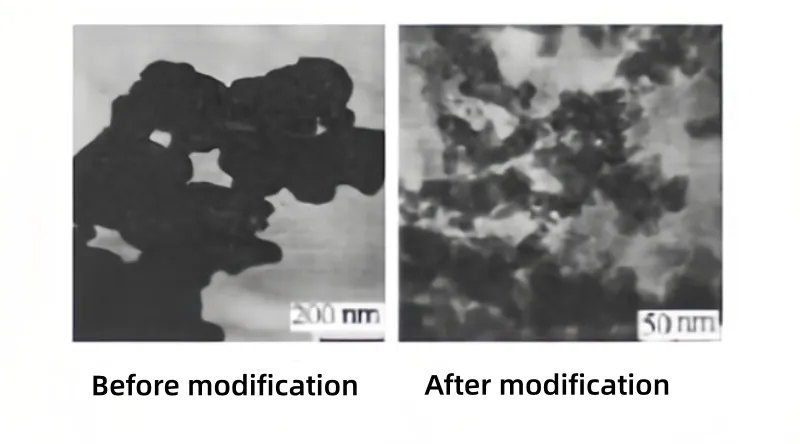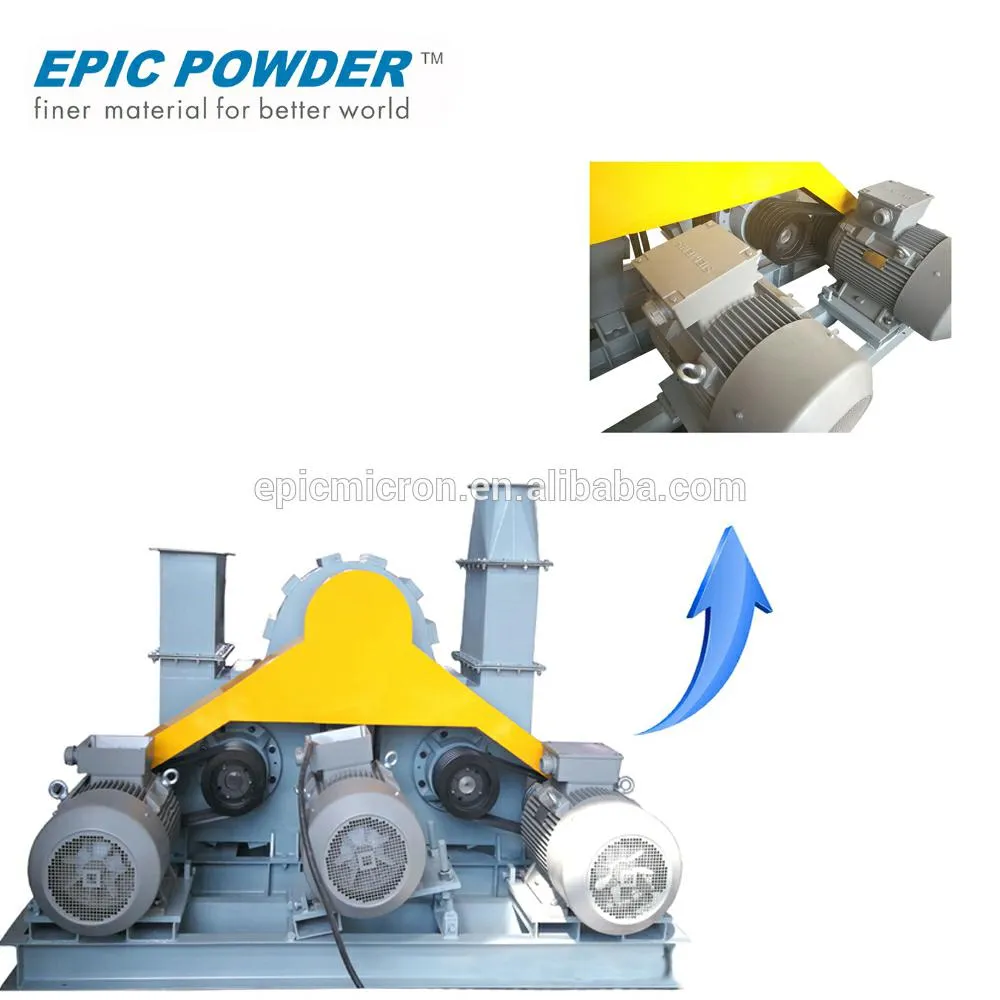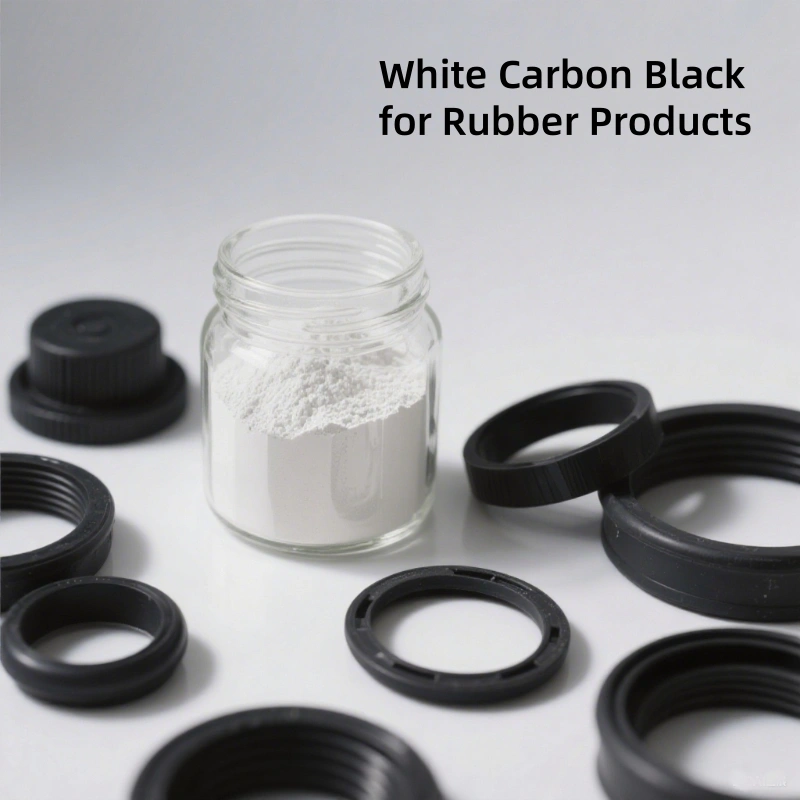ซิลิกาหรือที่เรียกว่าซิลิกอนไดออกไซด์ เป็นสารอนินทรีย์ที่สำคัญ เคมี วัตถุดิบ ด้วยโครงสร้างพื้นผิวและสัณฐานวิทยาของอนุภาคที่เป็นเอกลักษณ์ ซิลิกาจึงมีเสถียรภาพที่ดีเยี่ยม ความสามารถในการเสริมแรง พฤติกรรมการข้น และคุณสมบัติเชิงไธโซทรอปิก คุณสมบัติเหล่านี้ทำให้ซิลิกาเป็นสารตัวเติมอนินทรีย์ที่สำคัญในหลายสาขา เช่น ยาง สารเคลือบผิว และพลาสติก อย่างไรก็ตาม เพื่อปลดล็อกศักยภาพอย่างเต็มที่และเพิ่มความเข้ากันได้กับเมทริกซ์อินทรีย์ต่างๆ การปรับเปลี่ยนพื้นผิว มักใช้ซิลิกาเป็นส่วนประกอบ กระบวนการนี้เป็นสิ่งสำคัญในการปรับแต่งคุณสมบัติให้เหมาะกับการใช้งานเฉพาะด้าน

การปรับเปลี่ยนพื้นผิว ของซิลิกา
โครงสร้างโพลีไซลอกเซนภายในและหมู่ไซลานอลที่มีฤทธิ์ลดแรงตึงผิวทำให้ซิลิกาที่ตกตะกอนมีคุณสมบัติชอบน้ำสูง ส่งผลให้มีความสามารถในการเปียกและการกระจายตัวในเฟสอินทรีย์ต่ำ หมู่ไฮดรอกซิลบนพื้นผิวมีส่วนทำให้เกิดพลังงานพื้นผิวสูง ทำให้เกิดการเกาะกลุ่มกันซึ่งส่งผลต่อประสิทธิภาพของผลิตภัณฑ์ ในระหว่างการผลิต สิ่งนี้นำไปสู่การรวมตัว คุณสมบัติชอบน้ำ ต้นทุนสูง ประสิทธิภาพต่ำ และการใช้พลังงานสูง ภายใต้แรงกดดันด้านสิ่งแวดล้อมที่เพิ่มขึ้น การลดต้นทุน การปรับปรุงประสิทธิภาพ และการเพิ่มคุณสมบัติไม่ชอบน้ำบนพื้นผิวจึงมีความสำคัญอย่างยิ่ง
กลุ่มไฮดรอกซิลบนพื้นผิวซิลิกามีอยู่ 3 ประเภท:
- กลุ่มไฮดรอกซิลแยกซึ่งเป็นสิ่งที่เป็นอิสระและไม่ได้รับผลกระทบ;
- กลุ่มไฮดรอกซิลเจมินัลโดยที่ไฮดรอกซิลสองตัวมีพันธะกับอะตอมซิลิกอนตัวเดียวกัน
- กลุ่มไฮดรอกซิลที่เกี่ยวข้องซึ่งมีพันธะไฮโดรเจนเชื่อมต่อกัน
พื้นผิว การดัดแปลงซิลิกา เกี่ยวข้องกับการใช้สารปรับเปลี่ยนที่ทำปฏิกิริยาทางเคมีกับกลุ่มไฮดรอกซิลบนพื้นผิวเพื่อกำจัดหรือลดกลุ่มไซลาโนล ส่งผลให้คุณสมบัติของพื้นผิวเปลี่ยนไป

กระบวนการปรับเปลี่ยนพื้นผิว
จากลักษณะของตัวปรับเปลี่ยน การปรับเปลี่ยนพื้นผิวสามารถจำแนกได้เป็น ออร์แกนิก และ สารอนินทรีย์ การดัดแปลง ในบรรดาการดัดแปลงเหล่านี้ การดัดแปลงแบบอินทรีย์เป็นเทคโนโลยีที่ใช้กันอย่างแพร่หลายที่สุด เทคโนโลยีหลักสำหรับการดัดแปลงแบบอินทรีย์คือการบำบัดด้วยออร์แกโนไซเลน ซึ่งหมู่ฟังก์ชันอินทรีย์จะเข้ามาแทนที่หมู่ไฮดรอกซิลบนพื้นผิวซิลิกา
วิธีการดัดแปลงสารอินทรีย์โดยทั่วไปแบ่งออกเป็นวิธีแห้ง วิธีเปียก และวิธีอัดความร้อน ปัจจุบัน ประเทศที่พัฒนาแล้วส่วนใหญ่ใช้วิธีแห้งในการปรับเปลี่ยนซิลิกาฟูม
ข้อดีของวิธีแห้ง:
- กระบวนการง่ายๆ โดยมีขั้นตอนหลังการรักษาน้อยลง
- การบูรณาการที่ง่ายดายกับกระบวนการผลิตซิลิกาฟูม
- เหมาะสำหรับการผลิตในภาคอุตสาหกรรมขนาดใหญ่
ข้อเสียของวิธีแห้ง:
- การบริโภคตัวปรับเปลี่ยนที่สูง
- ต้องใช้มาตรฐานอุปกรณ์ที่สูงและเงื่อนไขการทำงานที่เข้มงวด
- ต้นทุนการผลิตค่อนข้างสูง
ที่ วิธีการดัดแปลงแบบเปียก ยังใช้กันทั่วไปและประกอบด้วยสองวิธีหลักๆ:

ข้อดีของวิธีเปียก:
- การใช้ตัวปรับเปลี่ยนที่ต่ำลง
- กระบวนการที่เรียบง่ายและมีความต้องการอุปกรณ์น้อยลง
- ต้นทุนการผลิตต่ำลงและการควบคุมคุณภาพที่ดีขึ้น
ข้อเสียของวิธีเปียก:
- กระบวนการหลังการรักษาที่ซับซ้อน
- ปัญหาเรื่องมลภาวะสิ่งแวดล้อม
- ยากที่จะขยายขนาดให้เพียงพอสำหรับการผลิตจำนวนมากในระดับอุตสาหกรรม
อีกวิธีหนึ่งในการดัดแปลงแบบเปียกคือ การดัดแปลงในสถานที่ ในระหว่างกระบวนการตกตะกอนของซิลิกา ซึ่งสามารถเพิ่มประสิทธิภาพและการบูรณาการได้
ตัวปรับเปลี่ยนทั่วไปและหลักการปรับเปลี่ยน
สารปรับเปลี่ยนทั่วไป ได้แก่ ไซเลนอินทรีย์ที่มีฮาโลเจน, สารจับคู่ไซเลน, ไซลิลามีน, ไซลอกเซน และสารประกอบแอลกอฮอล์ สารเหล่านี้มีพันธะทางเคมีกับหรือแทนที่หมู่ไฮดรอกซิลบนพื้นผิวของซิลิกา จึงช่วยเพิ่มคุณสมบัติการไม่ชอบน้ำ การกระจายตัว และความเข้ากันได้กับสารอินทรีย์
การประยุกต์ใช้ซิลิกาที่ดัดแปลง

ซิลิกาที่ดัดแปลงเป็นสารเสริมแรงที่สำคัญในผลิตภัณฑ์ยาง ช่วยเติมเต็มช่องว่างที่ คาร์บอนสีดำ ไม่สามารถใช้กับวัสดุสีอ่อนได้ ในการผลิตยางรถยนต์ การเติมซิลิกาที่ผ่านการปรับแต่งจะช่วยเพิ่มความแข็งแรงเชิงกลของยาง ลดการสูญเสียฮิสเทอรีซิส ลดแรงต้านการหมุน และรักษาความทนทานต่อการลื่นไถลบนพื้นเปียกได้อย่างดีเยี่ยม
ในสารเคลือบหลุมร่องฟันและกาว ซิลิกาที่ผ่านการปรับแต่งจะช่วยเพิ่มความสามารถในการกระจายตัว ความเข้ากันได้ และความทนทานของผลิตภัณฑ์ ในงานเคลือบ ซิลิกาทำหน้าที่เป็นสารเคลือบทั่วไปที่ทำให้เกิดการด้าน การใช้ซิลิกาที่ผ่านการปรับแต่งจะช่วยเพิ่มการกระจายตัวและลดปัญหาการรวมตัวหรือการตกตะกอน
เมื่อเปรียบเทียบกับซิลิกาธรรมดา ซิลิกาที่ปรับแต่งแล้วมีประสิทธิภาพโดยรวมที่ดีกว่าและมีขอบเขตการใช้งานที่กว้างขึ้น
บทสรุป
ซิลิกาดัดแปลงไม่เพียงแต่คงคุณสมบัติที่ดีเยี่ยมของซิลิกาทั่วไปไว้เท่านั้น แต่ยังมีคุณสมบัติกันน้ำและคุณสมบัติพื้นผิวที่ดีขึ้นอีกด้วย ซึ่งช่วยเพิ่มศักยภาพการใช้งานได้อย่างมาก ด้วยการพัฒนาทางเศรษฐกิจอย่างต่อเนื่อง ความต้องการซิลิกาดัดแปลงในตลาดจึงเพิ่มขึ้นอย่างต่อเนื่อง การพัฒนาเทคโนโลยีการผลิตซิลิกาดัดแปลงที่เป็นมิตรต่อสิ่งแวดล้อม คุ้มค่า และมีขนาดใหญ่ ได้กลายเป็นทิศทางสำคัญสำหรับผู้ผลิตซิลิกาในอนาคต
